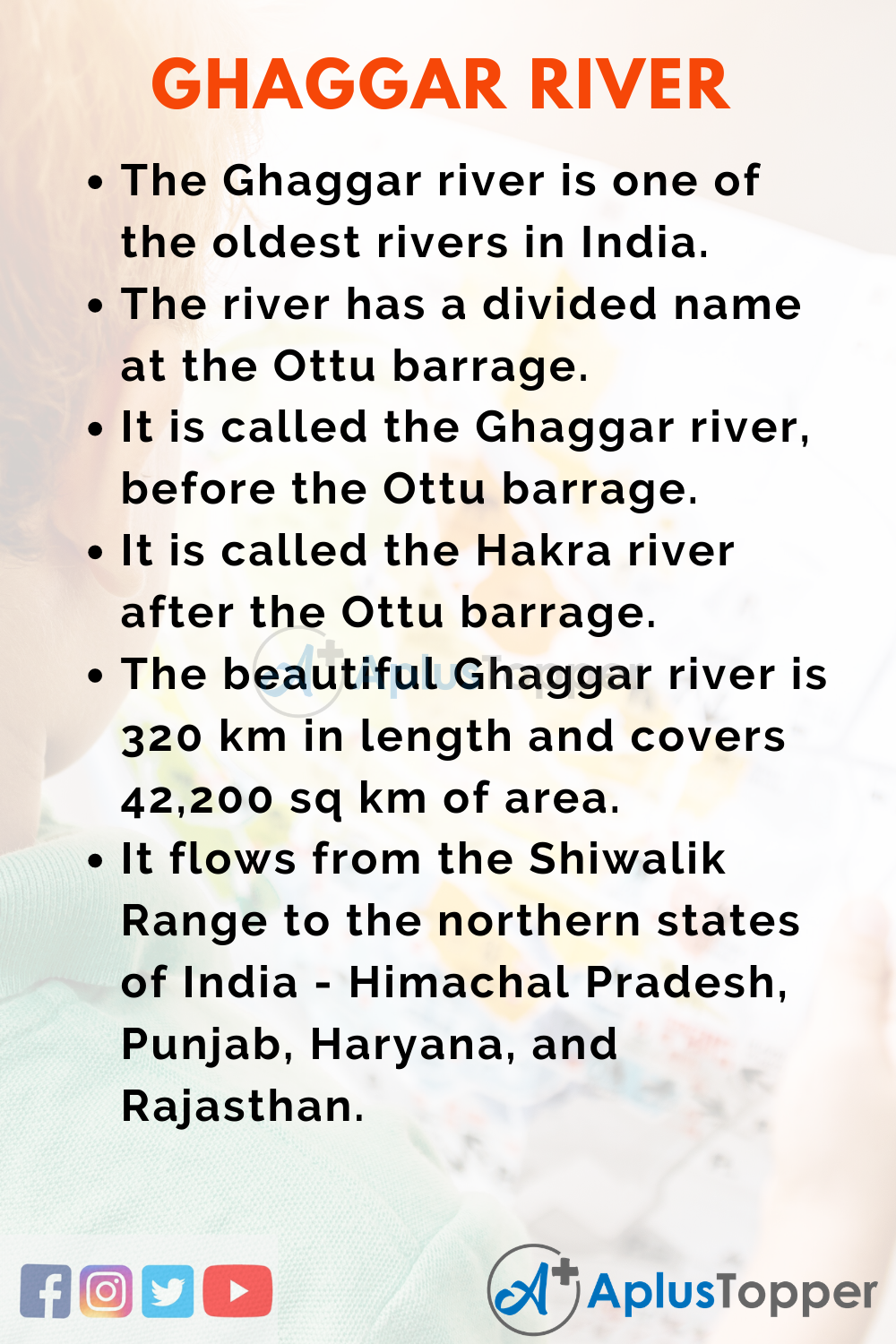10 Lines on Ghaggar River: Rivers are the source of life. All living organisms depend on rivers for livelihood. In India, rivers are considered holy. The eternal Ghaggar river runs down from Kalka in Shiwalik Range. It occupies the northern part of India, including states like Himachal Pradesh, Punjab, Haryana, and Rajasthan. Though man may have created boundaries to prevent free movement across the line of control, he does not have the power to stop the flowing rivers and air. The mighty Ghaggar river proves that nature does not hold prejudice against race, caste, or nationalism. It crosses the India-Pakistan physical boundaries with free will. The river is a link between India and Pakistan. Even the Rigveda of ancient India mentions the importance of the Ghaggar-Hakra river. The Harappan civilization is also said to recognize the perennial Ghaggar river.
You can read more 10 Lines about articles, events, people, sports, technology many more.
Set 1 – 10 Lines on Ghaggar River for Kids
Set 1 is helpful for students of Classes 1, 2, 3, 4 and 5.
- The Ghaggar river is one of the oldest rivers in India.
- The river has a divided name at the Ottu barrage.
- It is called the Ghaggar river, before the Ottu barrage.
- It is called the Hakra river after the Ottu barrage.
- The Ghaggar-Hakra river flows through the India-Pakistan border.
- It flows from the Shiwalik Range to the northern states of India – Himachal Pradesh, Punjab, Haryana, and Rajasthan.
- The beautiful Ghaggar river is 320 km in length and covers 42,200 sq km of area.
- However, the river dries up, as it crosses the Bahawalpur district of Pakistan.
- Kaushalya, Markanda, Sarsuti, Tangri, and Chautang are the chief tributaries of the Ghaggar river.
- Although it is dependent on the monsoon rain, the Ghaggar river has served several civilizations.

Set 2 – 10 Lines on Ghaggar River for School Students
Set 2 is helpful for students of Classes 6, 7 and 8.
- The Ghaggar river is an eternal river that has been flowing since the oldest Harappan civilization.
- It flows through 320 km crossing the India-Pakistan border with several tributaries.
- The rivers gradually dry out in Pakistan, but the monsoon rain replenishes the Ghaggar river with water every year.
- The Ghaggar river covers four states of India, namely, Himachal Pradesh, Punjab, Haryana, and Rajasthan.
- The tributaries of the Ghaggar river include Kaushalya, Markanda, Sarsuti, Tangri, and Chautang.
- The dry Rajasthan receives water from the Ghaggar river at the Sirsa district.
- The Ghaggar river is called a perennial river because it holds importance even in the ancient Vedas.
- The Ghaggar river supported life to the Harappan civilization, which depended on it for farming and other purposes.
- Archaeologists believe that the Ghaggar river is an older version of the Saraswati River.
- The Ghaggar river has two basins, namely Bangar and Khadar.
Set 3 – 10 Lines on Ghaggar River for Higher Class Students
Set 3 is helpful for students of Classes 9, 10, 11, 12 and Competitive Exams.
- The Himalayan-fed Ghaggar river originates at the Shiwalik Range in the Dagshai village of Kalka.
- The intermittent Ghaggar river flows into India’s neighbouring country, Pakistan. However, it dries up as it reaches the Bahawalpur district.
- It remains dry throughout the year, but it swells up during the monsoon season in Pakistan.
- The Ghaggar river flows in the northern part of India, including states like Himachal Pradesh, Punjab, Haryana, and Rajasthan.
- The Ghaggar river is brimming with fresh water when the monsoon rain replenishes it.
- The Kaushalya river branches out towards the left of the Ghaggar-Hakra river. The Markanda river, the Sarsuti river, the Tangri river, and the Chautang river are the tributaries at the right of the Ghaggar-Harka river.
- The Ottu barrage is built on the Ghaggar river, which has renamed it as the Ghaggar-Hakra river.
- It is known as a perennial river because traces of the rivers were found during 2500 BC
- The historical sediments of the 300 km section of the river prove that the Harappan civilization was highly dependent on the seasonal Ghaggar river for agricultural purposes and other activities.
- In ancient India, the tributaries of the Sutlej river were believed to be a part of the Ghaggar river, due to the fertile soil found at the banks of the river.

FAQ’s on 10 Lines on Ghaggar River
Question 1.
What is another name for the Ghaggar river?
Answer:
Another name for the Ghaggar river is the Ghagghar river or the Ghaggar-Hakra river.
Question 2.
With which country do we share the Ghaggar river?
Answer:
We share the Ghaggar river with our neighbouring country, Pakistan.
Question 3.
What is the length and breadth of the Ghaggar river?
Answer:
The Ghaggar river is 320 km long and covers 42,200 sq km of area.
Question 4.
Name the tributaries of the Ghaggar river.
Answer:
The Kaushalya river branches out towards the left of the Ghaggar river. The Markanda river, the Sarsuti river, the Tangri river, and the Chautang river are the tributaries at the right of the Ghaggar-Harka river.
